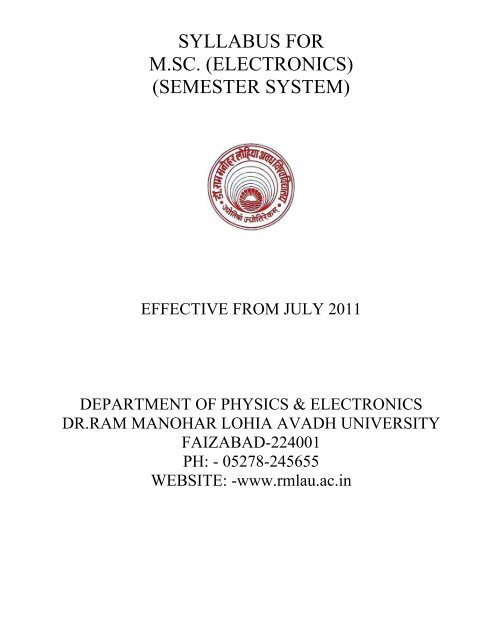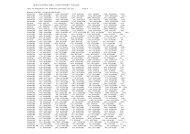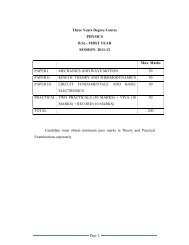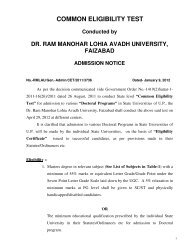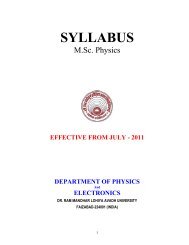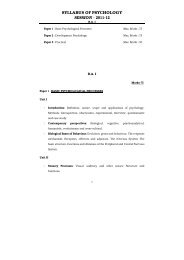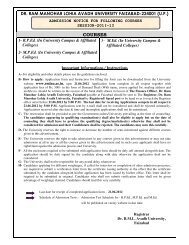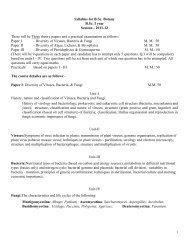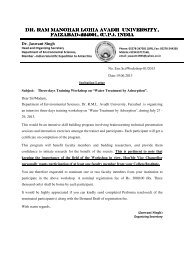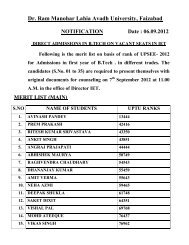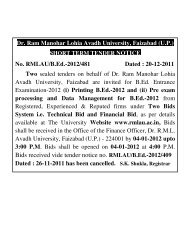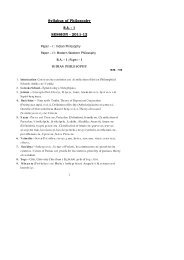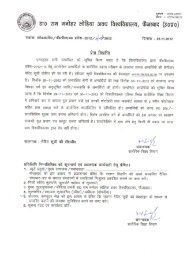syllabus for m.sc. (electronics) - Dr. Ram Manohar Lohia Avadh ...
syllabus for m.sc. (electronics) - Dr. Ram Manohar Lohia Avadh ...
syllabus for m.sc. (electronics) - Dr. Ram Manohar Lohia Avadh ...
You also want an ePaper? Increase the reach of your titles
YUMPU automatically turns print PDFs into web optimized ePapers that Google loves.
SYLLABUS FORM.SC. (ELECTRONICS)(SEMESTER SYSTEM)EFFECTIVE FROM JULY 2011DEPARTMENT OF PHYSICS & ELECTRONICSDR.RAM MANOHAR LOHIA AVADH UNIVERSITYFAIZABAD-224001PH: - 05278-245655WEBSITE: -www.rmlau.ac.in
PAPER-IV: ELE 104: CONTROL SYSTEMUNIT-I: Introduction, terminology and Feedback characteristics of control system definitions,closed and open loop systems, Transfer functions, block diagrams,Reduction Algenra,signal flowgraphs.UNIT-II: Time domain analysis and Root Locus Techniques:Standard test signals, time domain per<strong>for</strong>mance of control systems, transient response of the first,the second order systems, stability, steady state errors, effect of adding zero to the system, Routhstability criterion. Root locus techniques: The root locus concept, construction of root locus andanalysis of control system,UNIT-III : Frequency domain analysis and Basic control actions:Correlation between time and frequency response, Polar plots, Bode plots, experimentaldetermination of transfer function, log magnitude versus phase plots, Nyquist stability criterion,UNIT-IV: Basic actions and industrial control:Proportional, derivative and integral controllers, combined controllers, Effect of integral andderivative control on system, per<strong>for</strong>mance, PID controller.Reference Books :1. Control system Engineering – J.J. Nagrath, M. Gopal, 2nd Edition, Wiley Eastern Ltd.2. Modern Control Engineering – K. Ogata, Prentice Hall of India.3. Automatic control systems- B.C. Kuo, Prentice Hall of India.
PAPER-IV: ELE 204: POWER ELECTRONICSUNIT-I: Linear <strong>electronics</strong> Verses power <strong>electronics</strong>, applications of power<strong>electronics</strong>, Construction, operating principles, ratings and operating parameters of followingdevices - SCR, Thyristors types :- phase control, inverter grade, asymmetrical (ASCR) reverseconducting, (RCT), Gate assistated Turn off (GATT), Bidirectional diode (DIAC), TRIAC, SUS,SBC, SCS, LASCR, power transistors, power MOSFETS, IGBT, SITS, GTO, FCT, SITH, MCT,PIC.UNIT- II: Phase angle control, single phase, half wave control, full wave control, Half controlledbridge, voltage doubler, Three phase fully controlled, bridge, three phase half control bridge,selection of converter circuits, firing circuits, triggering circuits.UNIT -III: Control of dc to dc converter, step down (Buck) converter, step-up (Boost) converter,Buck-Boost converter, Cuk-dc-dc converter fill bridge dc to dc converter. Cycloconverters Dualconverters, microprocessor based firing <strong>sc</strong>hemes <strong>for</strong> dual converter. Classification, basic concepts,load resonant converter, zero voltage and /or zero current switching. Forced commutated thyristerinverters. i.e. Auxillary commutated inverters, McMurray commutated inverterUNIT –IV: Basic concepts, classification, series inverter, self commutated inverters, parallelinverters, single-phase bridge voltage source invecter, three phase bridge, voltage control of singlephase and three phase inverters, current source inverters, PWM inverters, Single phase, three phaseAC regulators. Switching dc power supplies linear power supplies, switching power supplies, dcdcconverter with electrical isolation, control of switch mode P/S, P/S protection, designingconcepts, Power Line, disturbances, Power conditioners and uninterruptible power supplies.Reference Books.:-1. Power Electronics P.C. Sen2. Power Electronics R.M. Jalnekar & N.B. Pasalkar3. Thyristor power Controllers. C.K Dubey, S. R. Doradla, A. Joshi & R.M. Sinha4. Electronic drives- Concept & Applications –Vedam Subrahmanyam(THM)5. Power Semiconductor drives-S.B.Dewan, G.R.Sleman, A.Strauphan ( WileyInt.Publ.-JohnWiley Sons.)6. Power Electronics –J.S.Katre (Technover Publication
FINAL YEAR-SEMESTER IIIPAPER-I: ELE 301: ELECTRONIC INSTRUMENTATIONUNIT-I: Classification of Instrument, Errors in measurement, accuracy, precision, significantfigures, statistical analysis, probability of error, limiting error, definition of Transducer, type oftransducers active and passive(reactive, inductive and capacitive)UNIT-II: Wheatstone bridge, A.C. Bridge and their application, Wheatstone bridge, Hay bridge,Schering bridge, photoelectric effect, Hall effect, piezoelectric effect thermoelectric effect andtheir applicationsUNIT-III: Electronic multimeter, Digital voltmeter, Digital frequency meter, Instrument <strong>for</strong>resistance, capacitance, inductance, voltage, current, power and power-factor, Digital storageo<strong>sc</strong>illo<strong>sc</strong>opeUNIT-IV: Measurement of displacement, flow, torque, strain, vibration measurement, ECG,Ultra-sonography, X-ray Tomography, CT Scan.BOOKS & REFERENCES:s1. Modern Electronic Instrumentation and Measurement techniques by A. Helfrick, W. Cooper(PHI)2. Measurement Systems, Applications & Design – E. O. Deoblin3. A course in Electrical and Electronics Measurement & Instrumentation by A.K.Sawhney4. Principles of Industrial Instrumentation: D.Patronbis,5. Electronics Measurement and Instrumentation : Oliver and Cage6. Electronic Instrumentation – Rajan & Sharma7. Instrumentation: Devices & Systems – Rangan, Sarma, Mani (TMH 3 rd Ed.)8. Biomedical Instrumentation by Khandpur,TMH
PAPER-II: ELE 302: MICROWAVE ELECTRONICSUNIT –I:Semiconductor microwave bipolar transistor, hetrojunction bipolar transistors,microwave tunnel diodes, MESFETs, CCD Devices, Gunn effect and Gunn DiodeRidley-Walkinhilsum(RHW) theoryUNIT –II: microwave linear beam tube(O type), klystron,reflex clystron, helix travelling wavetube(TWTs), Microwave cross field Tubes(M Type), MagnetronUNIT –introduction to transmission line, line equations and solution, reflection coefficient andtrasmission equation, standing and standing wave ratio, line impedence and admittance, smithchartUNIT –IV: wave guides (rectangular only), microwave hybrid circuit (waveguide Tee, magic Tee,waveguide corner, bends and Twists), directional couplers, circulators, Isolators, microstrip lines,parrallel strip lines, microstrip resonator and dielectric resonatorBOOKS & REFERENCES:1. Microwave Engineering – D. M. Pozar, Wiley Publication2. Microwave Engineering – R. E. Collin, McGraw Hill Publication.3. Microwave Devices And Circuits by S.Y.Lio,PHI4. Introduction of Microwave theory and Measurements by L.A.Lance,TMH
Chapter 7: The 23 rd Cycle Copyright © 2000 <strong>Dr</strong>. Sten OdenwaldTeledesic 1 (T1) experimental satellite is no longer operating as planned.Its purpose was to conduct a series of communications tests on threechannels between 18 - 450 MHz to demonstrate the high data ratecapabilities of the telemetry that will be used with the full network of 288satellites. No details were given, either to the cause of the malfunction,the systems involved, or the time when the satellite failed. Meanwhile,Motorola will complete the manufacture of these satellites in a whirlwind14 months, just as soon as they get the green light to start production.Celso Azevedo, President and CEO of the Lockheed Marten-supportedAstrolink notes in an interview with Satellite Communications magazinethat,"You have to minimize your technological risks. GEO architecture isproven. When utilizing new technology, developers have a tendency to gotoo far and stretch the envelope, which is what Teledesic is doing. Theproject is unlaunchable, unfinancable and unbuildable"The number of basic satellite designs also continues to fall as massproduction floods geospace with numerically smaller diversity of satellitesbased on similar designs and assumptions about space weather hazards.These designs are manufactured by Lockheed-Martin, Hughes andMotorola. For example, there are currently 40 HS-601 satellites of thesame model as Galaxy IV in operation, and these include PanAmSat'sGalaxy-7 and DirecTV's DBS-1 satellites which also experienced primarycontrol processor failures. Motorola's Iridium satellite network lost sevenof its identical satellites by August 1998. According to Alden Richards,CEO of Greenwich, Connecticut risk management firm, "These problemsare not insignificant. Insurers are clearly concerned that there have beenthese anomalies"More and more often, satellite insurance companies are finding
PAPER-IV: ELE 304: INTIGRATED AND DIGITAL ELECTRONICSUNIT-I: Operational Amplifiers: Introduction to Operational amplifier, Basic parameters,Inverting and Non-inverting amplifier, Applicability of Op-Amp in Analog computation: Solutionof simultaneous and differential equation, Op-Amp as voltage follower, Adder, Subtractor,Integrator, Differentiator, logarithmic amplifier, Antilog amplifier, Analog multiplier & Dividercircuit, RMS circuit.UNIT-II: Active filters( low pass & high pass of 1 st & 2 nd order), Comparator, Mutivibrator,Schmitt trigger, Sample and hold circuit, triangular wave generator, Voltage Controlled O<strong>sc</strong>illator,Phase locked loop(PLL) and its Application, A/D and D/A converter circits, 555 Timer..UNIT-III: Arithmetic Logic Operations And Circuits: Binary addition & subtraction, Halfadder, Full adder, Half Subtracter, Full Subtracter, Controlled Inverter and Adder-Subtracter, Dataprocessing circuits: Multiplexers, Demultiplexers, Encoder and Decoder (1 of 16 Decoder, BCDDecoder and LED Decoder).UNIT-IV: Flip-flop: R-S, D, T, J-K and J-K Master slave flip-flops. Asynchronous, Synchronousand Mod counters. Serial, parallel shift registers and counters.References:1. Integrated Electronics by – Millman & Halkias2. OPAMP and Linear Integrated Circuits By- R.A.Gayakwad3. Linear Integrated Circuits By- Choudhary and Jain4. Op. Amp and Linear Integrated circuit by Coughlin and <strong>Dr</strong>i<strong>sc</strong>oll.5. Digital Principle & Application By-Malvino Leach6. Modern Digital Electronics By- R.P.Jain7. Digital Electronics By Floyd8. Digital Electronics By Goathmann9. Digital Electronics By Tocci
PAPER-III: ELE 403: MICROPROCESSOR AND MICROCONTROLLERUNIT I: Hardware Architecture of 8085, pinout, data bus address bus and control bus, tristateswitches, latching of address bus, memory mapping and organization, register organization, timingdiagram of different cyclesUNIT II: assembly language programming, Instruction <strong>for</strong>mat and addressing modes, Assemblylanguage <strong>for</strong>mat, Data transfer, data manipulation & control instructions, stacks and subroutines,UNIT III: study of general purpose peripheral interfacing ICs 8155, 8255, 8253 and 8279, Directmemory addressing, DMA controllerUNIT IV: architecture of 8086, type of addressing modes 8086, segmented memory cycles,read/write cycle in min/max mode. Reset operation, wait state, Halt state, Hold state, Lockoperation and interrupt processing. Addressing modes and their features, Introduction to 8051microcontroller, architecture, configuration, I/O port Structure, registers, memory organizationBOOKS & REFERENCES:1. Microprocessor Architecture, Programming and Applications – R. S. Gaonkar2. Microprocessor and Digital Systems – D. Hall3. Microprocessor – S. I. Ahson4. The 8051 Microcontroller architecture, programming and application by K. J.Ayala.
PAPER-IV: ELE 404: OPTO ELECTRONICS AND OPTICALCOMMUNICATIONUNIT I: Review of P-N jn-characteristics – semiconductor-hetero junction, LEDs (spontaneousemission, LED structure-surface emitting, Edge emitting-Injection efficiency, recombinationefficiency, LED characteristics, spectral response, modulation, Band width, Laser diodes, Basicprinciple, condition <strong>for</strong> gain-Laser action-population inversion-stimulated emission, InjectionLaser diode, structure, temperature effects, modulation, comparison between LED and ILDs.UNIT II: Optical detectors-optical detector principle, absorption coefficient, detector,characteristics, Quantum efficiency, responsivity, response time-bias voltage, Noise in detectorsP-N junction-photo diode, characteristics, P-I-N-photo diode, response, Avalanche photo diode(APD) multiplication process-B,W-Noise photo transistor.UNIT III: Optical Fibre, structure, advantages, Types-propagation-wave equation, phase andgroup velocity, transmission characteristics, attenuation-absorption, <strong>sc</strong>attering losses-dispersion,fibre bend losses, source coupling, splices and connectors-wave length division multiplexing.UNIT IV: Optical fibre system, system design consideration, power budget, line coding, systemrise time, maximum bit rate, cannel width, electro-optic effect and applications, acousto-opticeffect and applications, nonlinear effect and applicationsBooks Recommended1. Optical Communication- John M. Senior2. Optical Communication –Gerd Keiser3. Optical communication and Systems- Pallies
Ordinance relating to newly adopted semester system in M.Sc. course inElectronics & Electronics, Faculty of ScienceOrdinancesA candidate who has passed B. SC. with Physics and/or Electronics is as a subject up to IIIrdyear and Mathematics as a subject at least up to second year and having minimum 50% marks inaggregate from a recognized university is eligible <strong>for</strong> admission.Admission will be made on merit of entrance test/merit of qualifying exam.The courses of M.Sc. Electronics degree shall consist of two academic sessions and each sessionshall consist of two semesters.A candidate enrolled <strong>for</strong> M.Sc. Electronics course shall be admitted to semester examination aftercompleting a regular course of study <strong>for</strong> at least 14 weeks in each semester.A candidate successful at all four M.Sc. Electronics semester examinations as specified in the regulationwill be awarded M.Sc. degree in Electronics.Regulations1- The examination <strong>for</strong> semester system in M.Sc. course in Electronics /Electronics shall be bymeans of theory papers and practical as specified in the examination <strong>sc</strong>heme which consist of(a)Four theory papers, practical examination in each of the first and third semesters.(b) Four theory papers, practical examinations, seminars and project Viva in second and fourthsemesters.2- The name of the candidates successful in the semester system in M.Sc. course in Electronicsexamination shall be arranged in the following classes.(a)(b)First class to those who secure 60% or more marks in aggregate.Second class to those who secure 45% or more marks in aggregate.3- The pass marks in each semester shall be(a)(b)30% marks in each theory papers subject to 40% marks in the total of theory.40% marks impractical examinations.


